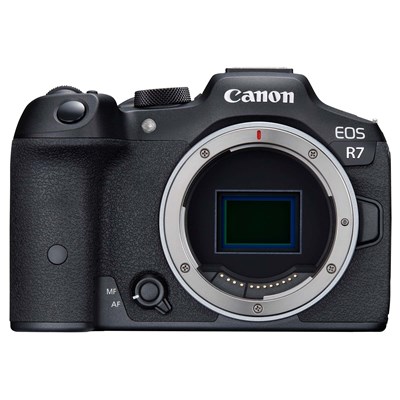Canon EOS R7 Digital Camera Body | Half Price Memory Card Offer | Wex Photo Video
The EOS R7 camera continues Canon’s legacy of formidable next-generation mirrorless tech, packing precision autofocus, state-of-the-art image stabilisation and incredible speed. This RF-mount camera with an APS-C sized sensor provides the ideal balance between resolution, speed and low-light performance for a truly hybrid result that’s capable of competing with other professional full-frame models.
The EOS R7 camera continues Canon’s legacy of formidable next-generation mirrorless tech, packing precision autofocus, state-of-the-art image stabilisation and incredible speed. This RF-mount camera with an APS-C sized sensor provides the ideal balance between resolution, speed and low-light performance for a truly hybrid result that’s capable of competing with other professional full-frame models.
Canon EOS R7 Camera Body Key Features:
- Large 32.5MP APS-C sized sensor for balanced resolution
- IBIS system for 7 stops of protection against camera shake
- Powerful DIGIC X Image Processor effectively refines images
- Shoot continuously with bursts at up to 15fps – or 30fps
- Dual UHS-II Card slots for longer shoots at higher specs
- Dual Pixel CMOS AF II system delivers pin-sharp action
- AF Tracking identifies humans, animals and vehicles
- 4K UHD video recording for incredible definition and clarity
- Wi-Fi connectivity for cloud storage and wireless printing
- Up to ISO 32,000 for stills (extendable to ISO 51,200)
- Up to ISO 12,800 for video (extendable to ISO 25,600)
- 1.62 million dot 2.95-inch TFT colour LCD monitor
- 2.36 Million dot 0.39-inch OLED colour EVF
Expanded Canon EOS R7 Camera Body Key Features:
Find The Perfect Balance
As the first camera in the EOS R range with an APS-C sized sensor, the EOS R7 is designed to provide the perfect balance between resolution, speed and low-light performance. Offering sensitivity up to ISO 32,000 for stills and ISO 12,800 for video, the EOS R7 has an incredible response to light for beautifully exposed images.
Each of the sensor’s 32 million pixels is also split into two photosites for Dual Pixel CMOS AF II focusing and Dual Pixel RAW capabilities. Dual Pixel CMOS AF operates in up to 651 autofocus zones (31 x 21) with virtually 100 per cent coverage of the frame – so you can capture all the finer details to produce stunningly sharp results.
The Perfect Sports and Wildlife Companion
One of the biggest perks of the APS-C sized sensor is the increased reach it gives your lens. The EOS R7 delivers 1.6x more telephoto reach than full-frame cameras of the same focal length – making this camera the perfect sports and wildlife photography companion. Not only is this an excellent solution for getting closer to the action, but it also affords greater detail in landscapes and more powerful portraiture.
Reinforcing the EOS R7 as the ideal sports and wildlife camera is the Dual Pixel CMOS AF II. Programmed using deep-learning AI, this AF system recognises people, animals and vehicles wherever they are in the frame. And, with the ability to shoot continuously at up to 30 fps with the silent electronic shutter, you can capture even the most fleeting moments whilst following your subjects with the AE lock and tracking AF.
Go Handheld with IBIS
Taking the EOS R7 into the realm of high-end mirrorless cameras is the in-body Image Stabiliser (IBIS). Working in concert with an RF lens’ optical IS, this system can deliver up to 7 stops of protection against camera shake. Even without an IS lens, the EOS R7 IBIS maintains highly effective stabilisation, so you can go handheld without worrying about too much blur.
The EOS R7’s in-body IS (IBIS) can also be used to auto-level images, making wonky horizons a thing of the past. This feature can be used in tandem with the IBIS and is available with both mechanical and electronic shutters – it also comes in handy when you’re attempting a panorama and works for any RF, RF-S, EF or EF-S lens.
4K UHD Video Recording
By investing in the EOS R7’s video capabilities, Canon has packed in some impressive features to make this camera an incredibly flexible shooter. The EOS R7 boasts 4K video with an oversampled 30fps mode, a slow-motion 60p mode and a separate crop mode. With Ultra-HD video recording and Canon Log 3, EOS R7 footage slots easily into professional editing workflows for vloggers, colourists and filmmakers alike. And, with support for vertical video, the EOS R7 is perfect for social media sharing.
Canon Cloud Processing
With Wi-Fi connectivity, the EOS R7 benefits from image.canon cloud features. RAW files can be processed to reduce noise and moire for more natural-looking JPEG and HEIF files. You can also get your content to wherever it needs to be by connecting to your smartphone and sharing your snaps on social media.
What’s in the box?
- 1 x Canon EOS R7 Camera Body
- 1 x Hand Strap E2
- 1 x Canon Battery LP-E6NH
- 1 x Battery charger LC-E6E
- 1 x Shoe Cover
Canon EOS R7 Digital Camera Body Product Video:
Canon’s new APS-C mirrorless cameras and lenses! | First look review
FAQs:
Does the EOS R7 support RAW+JPEG/HEIF simultaneous recording?
Yes, any combination of RAW + JPEG or RAW + HEIF is possible with the Canon EOS R7.
Can I use EF lenses on the EOS R7?
EF and EF-S lenses can be attached to the EOS R7 using Mount Adapter EF-EOS R, EF-EOS R Control Ring Mount Adapter or Drop-in Filter Mount Adapter EF-EOS R. EF-M lenses are not compatible.
Does the EOS R7 have Canon Log?
Yes. The EOS R7 benefits from Canon Log 3 for maximising the dynamic range of images and enhancing your colour grading experience.
What kind of connectivity does the EOS R7 provide?
The EOS R7 benefits from a SuperSpeed Plus USB 3.2 Gen 2 USB Type-C connector that can be used for computer communication, smartphone communication or USB power. Other ports include an HDMI Micro out (Type D, HDMI-CEC not supported), External Microphone In (3.5mm Stereo mini jack), Headphone socket (3.5mm Stereo mini jack) and RS-60E3-type terminal for remote controls.
Can I use the LP-E6 battery with this camera?
Yes. The EOS R7 can also be powered by LP-E6N and LP-E625 batteries. With LP-E6NH and LP-E6N, charging over USB is supported. However, with LP-E6 or unauthenticated batteries, charging over USB is not supported.
Additional information
| Size | 132.0 x 90.4 x 91.7 mm |
|---|---|
| Weight [g] | 530.00 |






Reviews
There are no reviews yet.